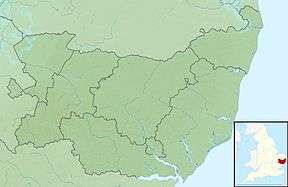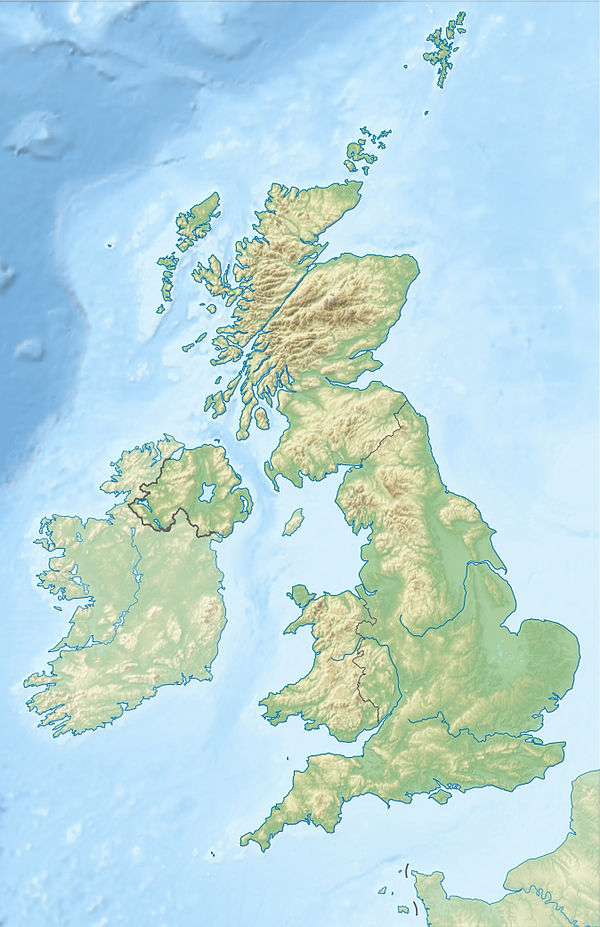Woodbridge, Suffolk
Woodbridge is a town in Suffolk, East Anglia, England, about 8 miles (13 km) up the River Deben from the sea. The town is served by Woodbridge railway station on the East Suffolk Line. It lies a short distance from the wider Ipswich urban area. Woodbridge is close to some of the main archaeological sites from the Anglo-Saxon period; one includes the Sutton Hoo burial ship. The town's 1100 years of recorded history have bequeathed a variety of historical architecture. It has facilities for boating and for riverside walks.
Woodbridge, Suffolk | |
|---|---|
 The harbour, with Woodbridge Tide Mill in the background | |
 Coat of arms | |
 Location within Suffolk  Location within the United Kingdom | |
| Coordinates: 52.094°N 1.318°E | |
| Sovereign state | United Kingdom |
| Constituent Country | England |
| Region | East Anglia |
| County | Suffolk |
| Population (2011) | |
| • Total | 7,749 |
| (2011 Census)[1] | |
| Postcode | |
| Area code(s) | 01394 |
| Website | www |

History and heritage
Archaeological finds in the area point to habitation from the Neolithic Age (2500–1700 BC). A ritual site was discovered while excavations were made for the East Anglia Array, a wind farm at Seven Springs Field.[2]
The area was occupied by the Romans for 300 years after Queen Boudica's failed rebellion in AD 59, but there is little evidence of their presence. After the Roman forces were recalled to Rome in AD 410, substantial Anglo-Saxon (Germanic) settlement ensued. The Angles gave their name to East Anglia.
King Rædwald of East Anglia was Bretwalda, the most powerful king in England in the early 7th century. He died about 624 and is probably the king buried at Sutton Hoo, across the River Deben from Woodbridge. The burial ship is 89 feet (27 m) long. The treasures discovered there in 1939 were the richest ever found on British soil. They are held now in the British Museum in London, but replicas of some items and the story of the finds can be seen in the Woodbridge Museum. The National Trust has built a visitor centre on the site.
The earliest record of Woodbridge as such dates from the mid-10th century, when it was acquired by St Aethelwold, Bishop of Winchester, as part of the endowment of a monastery he helped to refound at Ely, Cambridgeshire in 970.[3] The Domesday Book of 1086 describes Woodbridge as part of the Loes Hundred. Much of Woodbridge was granted to the powerful Bigod family, who built the castle at Framlingham.
The town has been a centre for boat-building, rope-making and sail-making since the Middle Ages. Edward III and Sir Francis Drake had fighting ships built in Woodbridge.[4] The town suffered in the plague of 1349, but recovered enough, with encouragement from the Canons and growing general prosperity, to have a new church (St Mary's, behind the buildings on the south side of Market Hill) built of limestone from the Wash and decorated with Thetford flint. By the mid-15th century the Brews family had added a tower and porch.
On 12 October 1534, Prior Henry Bassingbourne confirmed Henry VIII's supremacy over the Church and rejected the incumbent "Roman Bishop". Nonetheless, Woodbridge Priory was dissolved three years later.[5]
As religious unrest continued under the Roman Catholic Queen Mary Tudor, Alexander Gooch, a weaver of Woodbridge, and Alice Driver of Grundisburgh were burnt for heresy on Rushmere Heath. Alice had previously had her ears cut off for likening Queen Mary to Jezebel. Subsequent religious settlement under Elizabeth I helped Woodbridge industries such as weaving, sail-cloth manufacture, rope-making and salt making to prosper, along with the wool trade. The port was enlarged, and shipbuilding and the timber trade became lucrative, so that a customs house was established in 1589.
The town has various buildings of the Tudor, Georgian, Regency and Victorian periods, and a tide mill in working order, one of only two in the UK and among the earliest. The mill first recorded on the site in 1170 was run by Augustinian canons. In 1536 it passed to King Henry VIII. In 1564, Queen Elizabeth I granted the mill and the priory to Thomas Seckford, who in 1577 founded Woodbridge School and the Seckford Almshouses for the poor of Woodbridge. Two windmills survive, Buttrum's Mill, and Tricker's Mill, of which Buttrum's is open to the public.[6]
In 1943, the Royal Air Force (RAF) built a military airfield east of Woodbridge. RAF Woodbridge was used during the Cold War by the United States Air Force as the base for two Tactical Fighter Squadrons until 1993.
Governance
Woodbridge lies in the East Suffolk district of the shire county of Suffolk. The town council was formed in 1974 as a third-tier successor to the urban district council and has a mayor and 16 councillors elected for four wards.[7] The town lies in Suffolk Coastal parliamentary constituency and is currently represented by the Conservative Therese Coffey.[8] The county councillor is the Liberal Democrat Caroline Page.
Education and the arts
The town has state and grant-aided primary and secondary education at Farlingaye High School, Woodbridge Primary School, Kyson Primary School, and St Mary's Church of England Voluntarily Aided Primary School.[9] The co-educational independent Woodbridge School has junior and senior departments and facilities for boarding.[10]
Woodbridge has a community brass band, the Excelsior, formed in 1846, which makes it the oldest in East Anglia.[11] There is a local radio station.[12] The town also has a two-hectare (5-acre) walled park.[13] Also of interest ecologically are the Quaker Burial Ground[14] and Fen Meadow, 2.67 hectares (7 acres) of traditionally managed grassland.[15]
Sport and leisure
Woodbridge has a Non-League football club Woodbridge Town F.C., which plays at Notcutts Park.
The numerous clubs and associations in the town cover association football, badminton, birdwatching, bowls, cricket, cruising, netball, road running, rowing, rugby football,[16] swimming, tennis, golf (Ufford Park), yachting and archery.[17] They include Deben Rowing Club and Deben Yacht Club.
The town's Deben Leisure Centre and swimming pool underwent refurbishment in 2017–2018 and now provides fuller services since reopening.[18]
Places of worship
The two Church of England churches are the medieval St Mary's on Market Hill,[19] and the Victorian St John's on St John's Hill.[20]
Woodbridge Quay Church in Quay Street, once the Quay Meeting House, embodies a 2006 merger of the town's Baptist and United Reformed congregations. It is affiliated to the Baptist Union of Great Britain and the Evangelical Alliance.[21] There is a Methodist Church in St John's Street, a Salvation Army hall in New Street,[22] and the Roman Catholic Church of St Thomas of Canterbury in St John's Street. The last forms a joint parish with Framlingham.[23] Woodbridge Quaker Meeting meets weekly at Shire Hall. Avenue Evangelical Church, on the outskirts of Woodbridge, is affiliated to the Fellowship of Independent Evangelical Churches.[24]
Notable residents
Writers Edward FitzGerald and Anne Knight were born in Woodbridge, and fellow writer Bernard Barton lived in the town in later life.
Other residents of note include musicians Nate James and Charlie Simpson; actors Brian Capron and Nicholas Pandolfi; painter Thomas Churchyard; Director-General of the BBC Ian Jacob; abolitionist John Clarkson; Roy Keane the football manager, and Thomas Seckford, official at the court of Queen Elizabeth I. The clockmaker John Calver lived in the town.[25] Musicians Brian Eno and Brinsley Schwarz were born there.[26] The world's most tattooed man, Tom Leppard, was born in the town. So were the actor Gavin Lee and the footballer Vernon Lewis.
Twin Towns
Woodbridge is twinned with:
See also
References
- "Town population 2011". Retrieved 14 September 2015.
- Kennedy, Maev (28 June 2018). "Archaeologists stumble on Neolithic ritual site in Suffolk". the Guardian. Retrieved 28 June 2018.
- British History online. Retrieved 27 December 2019.
- Long, Peter (2004). The Hidden Places of England. Traveller Publishing Ltd. p. 514. ISBN 1904434126.
- The Abbey (Junior School), Woodbridge, British Listed Buildings. Retrieved 1 May 2011.
- English Heritage descriptions. Retrieved 20 December 2010.
- "About Woodbridge Town Council". Suffolk County Council. Retrieved 21 December 2010.
- "Election 2010: Results:UK>England>Eastern>Suffolk Coastal". BBC. Retrieved 21 December 2010.
- "A to Z of schools by village/town". Suffolk County Council. Retrieved 21 December 2010.
- "Retrieved 20 December 2010". woodbridge.suffolk.sch.uk.
- "Home". Home.
- "Community Radio for Woodbridge & The Deben Valley. Retrieved 20 December 2010". debenradio.co.uk.
- "Retrieved 20 December 2010". onesuffolk.co.uk.
- "Retrieved 20 December 2010". onesuffolk.co.uk.
- "Retrieved 12 December 2010". onesuffolk.co.uk.
- "Home – Woodbridge Rugby Club". Woodbridge Rugby Club.
- "Retrieved 20 December 2010". onesuffolk.co.uk.
- "Suffolk Coastal's Leisure Centre Redevelopment Programme » East Suffolk". www.eastsuffolk.gov.uk. Retrieved 12 March 2019.
- Community: Retrieved 20 December 2010. Architecture: Retrieved 20 December 2010.
- Community: Retrieved 20 December 2010. Architecture: Retrieved 20 December 2010.
- webmaster@woodbridgechurch.org.uk, Michael Astbury-. "Woodbridge Quay Church". www.woodbridgechurch.org.uk.
- "Retrieved 20 December 2010". woodbridgesalvationarmy.org.uk.
- Community: Retrieved 20 December 2010. Architecture: Retrieved 20 December 2010.
- "Avenue Evangelical Church – A Christ-centred, Bible-teaching, Evangelical church in Woodbridge". www.avenueevangelicalchurch.org.uk. Retrieved 4 November 2016.
- Garfield, Simon (19 October 2016). "Still ticking: The improbable survival of the luxury watch business | Simon Garfield". The Guardian. ISSN 0261-3077. Retrieved 5 July 2018.
- Miller, Andy (5 July 2008). "The life and times of Brian Eno". The Daily Telegraph. Retrieved 21 December 2010.
External links
| Wikimedia Commons has media related to Woodbridge, Suffolk. |
| Wikivoyage has a travel guide for Woodbridge (Suffolk). |
.jpg)